Abstract
The present paper presents a comparative study between the effects on the focused and distributive attention, felt by two groups of students, one group belonging to the specialization “Machine Building Technology” within the Faculty of Mechanics and Technology and the other group, with the specialization Sport and motor performance, belonging to the Department of Physical Education, University of Pitesti. The major difference between the two groups is the fact that, according to the curriculum, the ones within SPM practice daily physical exercises in a percentage of 7.14%, while the ones within TCM have a practice percentage of only 0.59%. The beneficial effects of physical exercises on the body, in the physical, somatic, functional, mental and social fields, are unanimously recognized. It is physical activity that can connect brain and muscle activity to keep both active. It has been proven that physical exercises favour the development of dendrites, the release of endorphins that improve the mood and improve the learning capacity and memory, etc. For this reason, as a specialist in the field of physical education and sport, I ask myself: how can we, through the methods and means we have at our disposal, contribute to the improvement of the focused and distributive attention so necessary in everyday activities, thus ensuring an increased efficiency of the activity by maintaining a long-lasting focus.
Keywords: Attention, physical exercises, students
Introduction
Attention is one of the most requested mental processes in carrying out human activities, regardless of their degree of complexity. Focused attention, distributed attention, can really be a challenge.
How to really focus, to be effective, in a vibrant world, with many implications, but also with many distracting stimuli? Hari (2022) lists twelve forces that affect our ability to concentrate, and without it we cannot achieve our goals.
We say that we see everything around us, that we are vigilant. Wrong. We also say we’re multi-operational (Golu, 2005). We’re actually moving faster from one task to another. Focused attention helps us to effectively complete a work task. Motivation is fundamental to concentration (Epuran et al., 2001).
Attention involves two neurofunctional states: wakefulness and alertness. Collective sports activities, in addition to the socialization effect, also contribute to the development of attention (Roşu et al., 2022).
Focusing your attention on certain stimulus involves, at the same time, inhibiting other stimuli (Mateescu, 2021), which determines a so-called “sensory and organizational filtering phenomenon”, as well as self-regulation of psycho-nervous energy. The entire psychic system, often the physiological system, interfere with the act of attention (Epuran, 1976). Attention is a “sine qua non” condition of effective action. Also “increase of attention and the intensity in focusing is accompanied by an increased resistance to the influence of disruptive stimuli” (Grosu, et al., 2014)
Attention can be described by the following attributes: Focus / Stability/ Distributive/ Flexibility/ Volume.
Attention requires the direct participation of consciousness. There is no other element of the mind to be mentioned as often in daily school, professional, domestic activities (“Pay attention at school”, “Pay attention when crossing the street”, “Pay attention when working”, “Pay attention...”
Any profession puts specific demands on the human body, inducing at some point fatigue. There are professions involving different levels of potential risk, obviously, requiring in particular the qualities of the above-mentioned attention. More and more often we hear about stress which is the result of overwork, various activities, different tasks, and deadline. We are talking about the way in which man organizes his daily activity with everything that this entails. Have we taken the time to analyse and schedule our activities based on how efficient we are throughout the day, meeting our goals and not being stressed?
It's really hard, especially since most of us have a work schedule that we have to keep to.
From a physiological point of view, the basis of attention is the orientation reflex, a reflex that allows an optimal reception of the stimuli of interest and the inhibition of the others. In (Nir & Julie, 2021) present strategies for concentrating attention, considering it fundamental in "controlling time". Researchers tell us that attention and the ability to focus are the raw materials of creativity and evolution. In the age of progressive automation, the most sought-after jobs are those that require creative problem solving, innovative solutions, and the kind of human ingenuity that comes from focus.
We also know that the one who “dictates” knowledge, thinking, memory, consciousness, emotional states, motivation, skills, attitudes, behaviour, etc. is the brain, a “great unknown”, still, at this moment, as specialists say. The brain needs constant energy and permanent activity to ensure complex processes, such as nervous flow transmission, cytokine signalling, inhibition of cell death, maintaining the activity of mitochondria, synthesis of genetic proteins, etc.
Attention, throughout the day is physiologically more active at 10 o’clock. Experts also say that maintaining the attention at an optimal level can be achieved only 90 minutes after which there is a break of about 20 minutes.
Focusing on a stimulus, an object, thought or activity involves sensory, intellectual and motor demands. Author Wallace (2016), advocates a mindfulness lifestyle.
That is why a considerable fund of tests for attention was developed, (Popescu & Arădăvoaice, 2003) among which we mention: the Toulouse-Pieron (B4), Klazov, Prague, Kraepelin, Bourdon-Amfimov tests, Platonov tables, Bonardell (complex reactivity), etc. Such evidence shall relate primarily to the ability to concentrate, to distributiveness or to commutativity.
Physical education classes, with the help of specific means of action, the exercise in the form of a competition, didactic games and dynamic games, “provide the opportunity, the conjuncture in which a subject fully manifests personal qualities...attention, perseverance, firmness, the ability to collaborate, the desire to defeat, the aesthetic taste, the presence of dynamic stereotypes, the level of acquisition of motor skills” (Popescu, 2016, p. 53).
In its higher forms, attention is learned, perfected, organized, and becomes efficient, involving above all the role of will and thought.
According to the study “Martial arts can improve your attention span and alertness long term – new study”, showed that people who practice martial arts have a higher level of attention span, as well as a higher level of alertness. The participants with the greatest experience in this sport had the highest level, the authors concluding that the benefits for attention are not limited to the post-workout period, but it is a lasting effect (Johnstone & Marí-Beffa, 2018, p. 9). A similar study shows an above-average concentration capacity of the students who practices sports (Pavel & Rata, 2015). Also (Sava, 2019), the level of distributed attention among schoolchildren was improved with the help of physical exercises and attention games.
Problem Statement
How can we, through the methods and means we have, through the constant rhythmic practice of physical exercises, contribute to the improvement of the focused and distributed attention so necessary in daily activities, thus ensuring an increased efficiency of the activity by maintaining a long-lasting focus, so much demanded nowadays?
Knowing that attention is an extremely important psychic process and also knowing that physical exercises, practiced in various forms, develop its attributes, we have established that the objective of our research is to study the difference between the level of distributive attention in the two groups of students of different fields of study.
At the first test, in which we applied the Prague Test and the Distributed Attention Test, we followed the level of attention in optimal conditions of concentration, the students not being distracted by noises, movement or lights;
The tests were also completed at 10 a.m., when attention is more physiologically active at this time;
At the second test we followed the ability to resist distractions through disturbances (students intentionally completing the Prague Test and the Rhomb Distributed Attention Test in a gym where a basketball training was held)
In addition, the tests were completed at 17.00 p.m.
Research Questions
The hypothesis of this paperwork
- There are significant differences between the level of attention of the two groups of students.
- Under conditions of distraction, students within SPM will be able to focus better on the tests.
: 40 students, aged between 19-27 years old, 20 of them being enrolled in: “Machine Building Technology” and the other group, also 20 students, in Sport and motor performance.
Considering the pandemic conditions and restrictions in the first semester, we chose to carry out this study only in the second semester of the 2021-2022 academic year, applying the Prague Test and the Rhomb Distributed Attention Test at the beginning and towards the end of it, in the form of initial testing and final testing.
By calculating the time spent on physical exercises in accordance with the approved curriculum, it turned out that the group of students within SPM practices in a percentage of 7.14%, while those within TCM have a percentage of practice of only 0.59%. We can see this in figure 1.
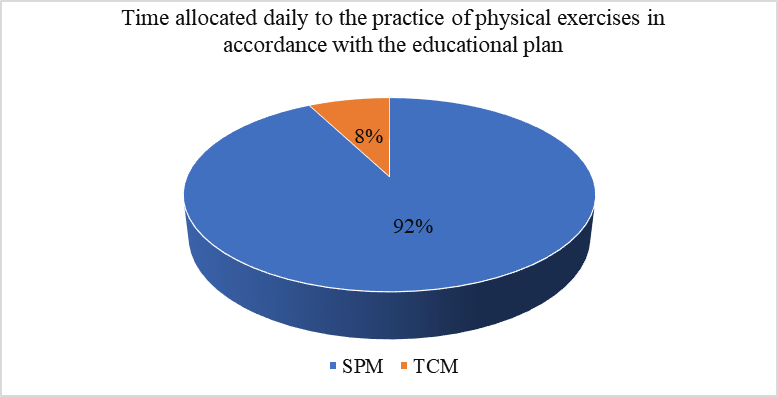
In figure 2 we present the comparative results of the two groups at the threshold test, both tests.
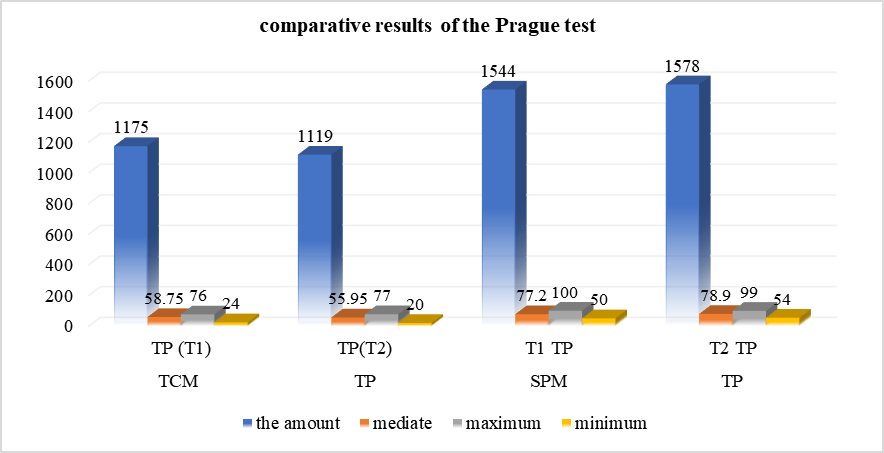
Also, in figure 3 we present the comparative results of the two groups in the rhombus test, both tests.
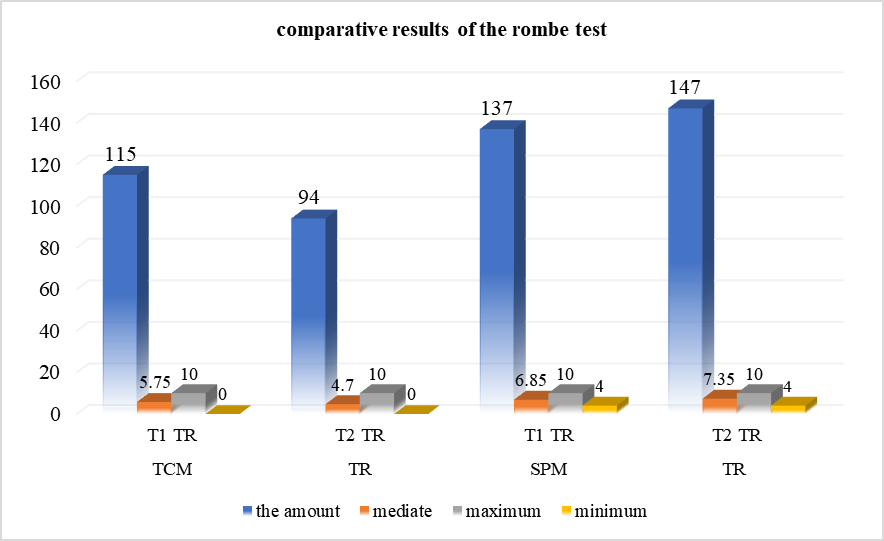
The results obtained by the two groups, in the two tests, initial and final checks, were statistically interpreted, the values obtained being presented in figure 4.
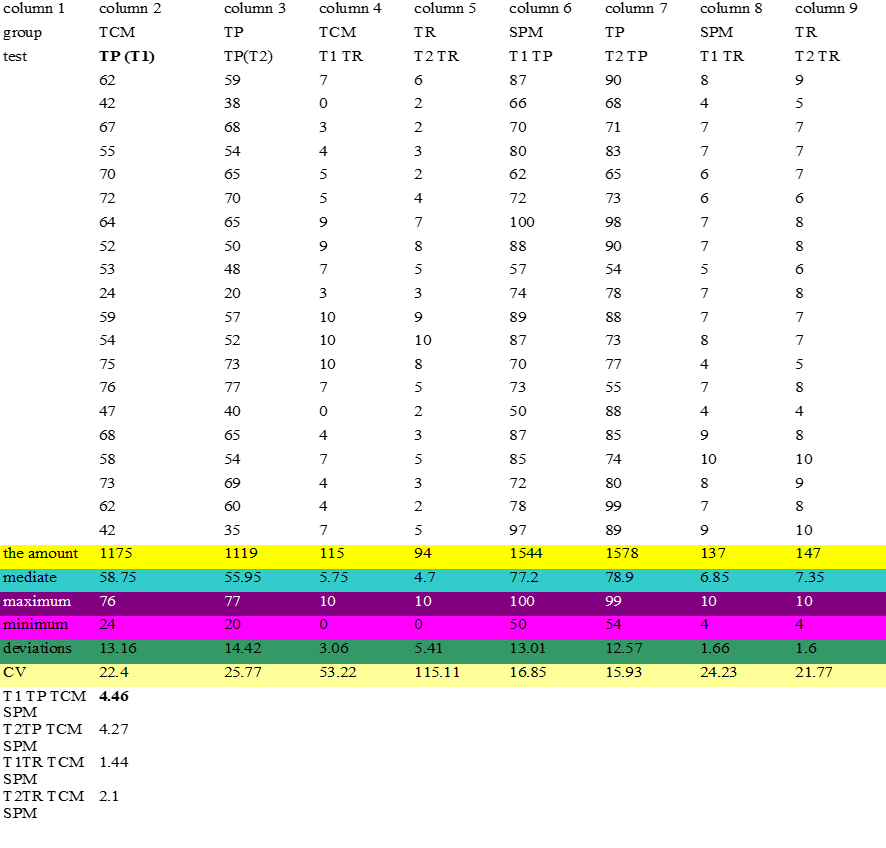
The calculation of the coefficient of variability for each test, each group, necessary to assess the level of homogeneity of the groups, highlights, as can be seen in the table 2, that we do not have any homogeneous group, only 2 groups being relatively homogeneous.
In the table 4 we have presented the student response frequency for the Rhomb test”, we chose this sample because the distribution segment is smaller, respectively from 0 to 10.
At the ,,Rhomb test” test 2, the students within SPM specialization focused better in conditions of phonic distraction and movement, achieving even a better average than the first test, as can be seen in figure 4.
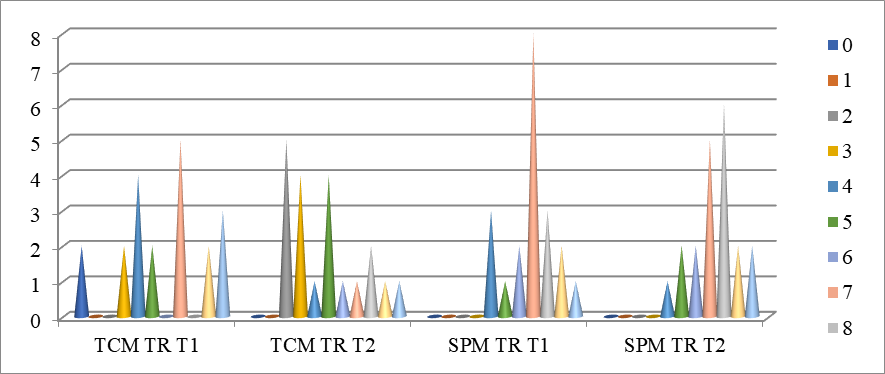
In Figure 5, there is an obvious difference in the means of the rhombus test in the case of the two groups.

Purpose of the Study
The research plan to determine the level of attention of the two groups of students , from year II SPM and year II TCM, consisted of:.
- composition of the two groups,
- application of attention tests: Prague and Rhomb at the beginning of semester 2 / at 10 a.m.
- application of attention tests: Prague and Rhomb at the end of the 2nd semester/at 17.00 p.m.
- calculation of achieved points
- interpretation of the results obtained
- drawing conclusions
- writing the paper.
Research Methods
In order to achieve the specific objectives that we set ourselves: testing the distributed attention of students of different fields of study, we used (in the order of intervention in the research carried out), scientific documentation, the application of the Prague and Rhomb tests, the graphical and statistical method.
Findings
1. Our study respected the principles of the composition of the groups of subjects, these being students of the second year of study, in both groups having girls and boys.
2. We applied the same tests to both groups, at the same hours and under the same stress conditions, the results obtained and the statistical analysis performed confirming that the SPM group demonstrated a better level of distributive attention.
3. The variable “time allocated to the exercise” is the one that brings marked differences between the two groups, as we specified in the introduction, the average per day at SPM is 7.17 compared to 0.59 at TCM. It is the central element from which we started in the elaboration of the 2 hypotheses.
4. In the elaboration of the 2 hypotheses we started from the premise that all sports require psychomotor skills which they then develop, including attention, with all its attributes.
Conclusions
1. Regarding the first hypothesis of our research, “there are significant differences between the level of attention of the two groups of students”, by calculating the significance of the differences between the means, uncorrelated samples, we can make the following statements:
for the initial testing T1 and T2, respectively, the “Prague Test”, applied to the 2 uncorrelated samples, i.e. the student group within TCM and the student group within SPM, resulted in a t-test value of 4.13 and 4.27 (T2), respectively. Looking in Fisher’s table for values of the variable “t”, we found this value at a threshold of 0.01T1/ and 0.1 T2, significant differences in both tests. The null hypothesis is rejected for this test TP/T1, T2 so that we can say with certainty that the attention of the students within SPM is superior.
for the initial testing T1 and T2, respectively, the ,,Rhomb test” applied to the 2 uncorrelated samples, i.e. the group of students within TCM and the group of students within SPM, resulted in a t-test value of 1.44 and 2.1 (T2), respectively. Looking in Fisher’s table for values of the variable “t”, we found this value at a threshold of 0.2 T1/ and 0.02 T2, significant differences in both tests. The null hypothesis is rejected for this test TR/T1, T2 so that we can say with certainty that the attention of the students within SPM is superior.
Therefore, based on these results we affirm that the first hypothesis of our work is confirmed.
2. Regarding the second hypothesis of our research, in conditions of distraction of attention, the students within SPM will be able to focus better on the tests, we have the following arguments:
At TCM the difference between T2 and T1 is negative, marking a decrease of 1.05, while at SPM the results are better by 0.5, the gap between the two being 1.55 points. On the other hand, the worst SPM result starts from 4 points, while with TCM from 0 points achieved!
3. As mentioned in the introduction, the time allocated to the practice of physical exercises, for the group of students within SPM is 7.14%, while those within TCM have a percentage of practice of only 0.59%, calculated according to the provisions of the curriculum, this variable being the positive response of our research.
References
Epuran, M. (1976). Psychology of physical education and sports. Editura Sport-Turism.
Epuran, M., Holdevici, I., & Tonița, F. (2001). Performance Sport Psychology. Theory and Practice. Editura FEST.
Golu, M. (2005). The basics of general psychology. Editura Universitară.
Grosu, V. T., Grosu, E. F., & Dumitrescu M. (2014). The role of attention in adjusting the behavior of junior skiers. Sport & Society/Sport si Societate, 14(1). https://www.researchgate.net/publication/349203447
Hari, J. (2022). Stolen Focus. Why You Can't Pay Attention. Editura TREI.
Johnstone, A., & Marí-Beffa, P. (2018). The Effects of Martial Arts Training on Attentional Networks in Typical Adults. School of Psychology. Bangor University. Sec. Cognitive Science DOI:
Mateescu, M. (2021, April 09). Attention and its role in school success. Blog https://www.itsmagic.ro/blog/atentia-%C8%99i-rolul-ei-%C3%AEn-reu%C8%99it%C4%83-%C8%99colar%C4%83.html
Nir, E., & Julie, L. (2021). Concentrated. How to control your attention so you can choose. Editura Curtea Veche.
Pavel, S., I., & Rata, G. (2015). "Study on the level of attention to students faculty physical education and sports," Impact of Socio-economic and Technological Transformations at National, European and International Level (ISETT). Institute for World Economy. Romanian Academy.
Popescu, D. C. (2016). Tests for the evaluation of handball players. Editura Universității din Pitești.
Popescu, S., & Arădăvoaice, G. (2003). Self-knowledge through psychological tests. Editura ANTET XX PRESS.
Roşu, D., Cojanu, F., Ştefănică, V., & Enache, S. (2022). Experimental management of work collectives through social and socialization activities. Journal of Physical Education and Sport, 22(7), 1742-1747. DOI:
Sava, M.-A. (2019). Study on Improving Distributive Attention by Using Movement Games Third Grade Students. GYMNASIUM, 20(2), 148-161. DOI:
Wallace, B. A. (2016). The attention revolution. Editura Atman.
Copyright information

This work is licensed under a Creative Commons Attribution-NonCommercial-NoDerivatives 4.0 International License.
About this article
Publication Date
10 April 2023
Article Doi
eBook ISBN
978-1-80296-961-0
Publisher
European Publisher
Volume
5
Print ISBN (optional)
-
Edition Number
1st Edition
Pages
1-1463
Subjects
Education sciences, teacher education, curriculum development, educational policies and management
Cite this article as:
Stancu, M., & Corina Popescu, D. (2023). The Effects of Sport Practice on Student Attention Capacity - Different Specializations. In E. Soare, & C. Langa (Eds.), Education Facing Contemporary World Issues - EDU WORLD 2022, vol 5. European Proceedings of Educational Sciences (pp. 1313-1322). European Publisher. https://doi.org/10.15405/epes.23045.133

